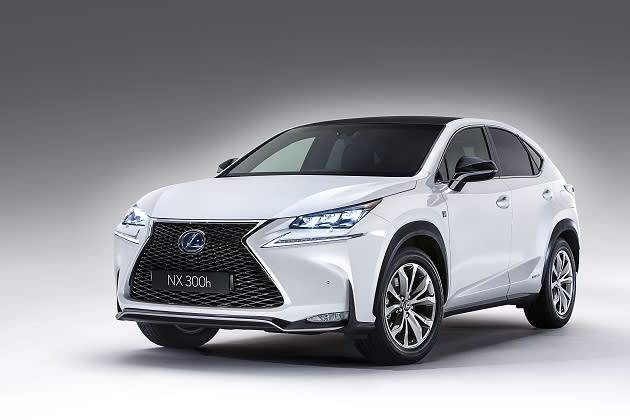Lexus takes its NX ‘big’ step

Lexus recently unveiled the full-production version of its compact sport-utility vehicle (CSUV), the Lexus NX, at the Beijing Motor show.
With styling previewed in the Lexus LF-NX concept that debuted at the Tokyo Motor Show last year, the NX is designed according to the brand’s current design principles, but it also brings obvious contrast.
As a CSUV, it measures only 4.6-metres in length and is 1.6-metres high, slightly larger than the other 'small Lexus', the CT 200h small hybrid hatchback. The NX pairs its modest dimensions with more aggressive styling and, as part of the current automotive craze, a raked, coupe-like roofline.
As with other current Lexus models, buyers will have the option of increasing the visual ‘volume’ with an optional F Sport package that contains , according to Lexus, “a sportier design and dedicated styling elements, including an exclusive rendering of the Lexus spindle grille, a lowered front bumper, specific alloy wheel designs, sports seats and bespoke interior trims.”
Three drivetrain options, in front wheel drive or all-wheel drive flavours, will be available globally at the car's international debut in July this year, with a Singaporean launch likely to happen before the end of 2014. As expected, a hybrid version, the NX 300h, will feature the petrol-electric drivetrain from the current IS 300h, with a 2.5-litre inline four engine mated to an electric motor and 195bhp in total.
An entry-level version of the NX will feature a 2.0-litre, naturally-aspirated inline four-cylinder engine.
The most interesting NX variant will be the NX 200t, which will have the first modern Lexus turbocharged engine to date, a 2.0-litre turbocharged unit with 235bhp from 4,800 to 5,600rpm and 350Nm of torque from 1,650 to 4,000rpm. Other tech the NX will debut include a wireless charging tray for mobile devices and a new version of the Lexus Remote Touch infotainment system with an actual touchpad.
The NX is arguably the most radical Lexus model to date, but this move hasn’t been entirely un-anticipated.
Since its debut in the USA in 1989, Lexus has concentraded on traditional, high-volume segments such as large SUVs (the RX model for example) and premium sedans/limos. In Singapore alone, the Japanese brand’s line-up consists of four sedans/limos (the IS, ES, GS and LS).
The proliferation into niche segments has been spearheaded primarily by German luxury car brands, with offerings such as the Mercedes-Benz GLA, also a CSUV, and the BMW 2 Series, a compact coupe.
With younger consumers around the world turning their attention away from automobiles, carmakers have had to innovate to catch the attention of the so-called Generation Y spenders.
Without non-traditional offerings, premium brands like Lexus risk being left behind in terms of sales, a factor exacerbated by an ageing segment of raditional buyers, and missing out on younger consumer dollars at the same time.
Lexus is obviously aware of this. Takeaki Kato, the NX Chief Engineer, is quoted in the Lexus press release as saying: “The NX is a premium crossover, combining performance, numerous on-board technologies and alluring design. Much like high quality sports watches, bikes and fashion accessories, the NX can be likened to the ultimate in premium sports gear."
To give an idea of the increased importance of niche segments, Mercedes-Benz is expecting its GLA CSUV to be a key seller here alongside the new C-Class sedan, the cars launch here in May and July, respectively, and it boasts that its newest range of compact vehicles, which include the successful CLA sedan, have brought it new audiences both in Singapore and abroad.



